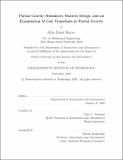| dc.contributor.advisor | Dava J. Newman. | en_US |
| dc.contributor.author | Harvey, Alvin Donel. | en_US |
| dc.contributor.other | Massachusetts Institute of Technology. Department of Aeronautics and Astronautics. | en_US |
| dc.date.accessioned | 2021-01-06T18:34:04Z | |
| dc.date.available | 2021-01-06T18:34:04Z | |
| dc.date.copyright | 2020 | en_US |
| dc.date.issued | 2020 | en_US |
| dc.identifier.uri | https://hdl.handle.net/1721.1/129195 | |
| dc.description | Thesis: S.M., Massachusetts Institute of Technology, Department of Aeronautics and Astronautics, September, 2020 | en_US |
| dc.description | Cataloged from student-submitted PDF of thesis. | en_US |
| dc.description | Includes bibliographical references (pages 227-237). | en_US |
| dc.description.abstract | Humans exhibit an abrupt switch from walking to running in Earth gravity, suggesting at different gaits being modulated by different neuronal networks. This abrupt change is indicated in significant changes in muscle activity during a gait transition. However, in partial gravity the transition between classically defined walking and running does not exhibit an abrupt change, suggestive of a continuous shift of one set of central pattern generators. This thesis investigates gait transitions in partial gravity using the Dynamic Systems Theory as a basis. To assess gait changes in partial gravity, the Moonwalker-III partial gravity simulator is designed with a novel harness system that features superior comfort and degrees of freedom. | en_US |
| dc.description.abstract | Partial gravity gait transitions are examined by using the Dynamic Systems Theory with three hypotheses including: (1) treating the speed of locomotion as a task constraint, and the resulting change in stride frequency and length, as control parameter across different reduced gravity levels will show that the central nervous system does not tune itself during gait transitions in partial gravity. Instead the influence that the stride frequency and length has on gait transition determinants is robust enough to remain intact and distinct in partial gravity, (2) classical definitions of walking and running require adjustment for partial gravity locomotion to match the neuromuscular indications of distinct gaits, (2) previous research in examining partial gravity gait transitions have not reached the task constraints necessary for gait transitions as described in the Dynamic Systems Theory Eight healthy subjects complete a walk-to-run procedure in Earth, Martian, and Lunar gravity. | en_US |
| dc.description.abstract | Measurements taken include the muscle activity of six leg muscles, stride length, stride frequency, and peak knee flexion. Treating stride frequency and stride length as a control parameter across different gravity levels shows that the central nervous system does tune itself during gait transitions in partial gravity, and that the transitions determinants in the Dynamic Systems Theory do not apply to partial gravity. The task constraint of speed of locomotion, which affects the stride frequency and length has been reached enough to refute the use of the presently existing Dynamic Systems Theory in partial gravity. | en_US |
| dc.description.statementofresponsibility | by Alvin Donel Harvey. | en_US |
| dc.format.extent | 237 pages | en_US |
| dc.language.iso | eng | en_US |
| dc.publisher | Massachusetts Institute of Technology | en_US |
| dc.rights | MIT theses may be protected by copyright. Please reuse MIT thesis content according to the MIT Libraries Permissions Policy, which is available through the URL provided. | en_US |
| dc.rights.uri | http://dspace.mit.edu/handle/1721.1/7582 | en_US |
| dc.subject | Aeronautics and Astronautics. | en_US |
| dc.title | Partial gravity simulators, harness design, and an examination of gait transitions in partial gravity | en_US |
| dc.type | Thesis | en_US |
| dc.description.degree | S.M. | en_US |
| dc.contributor.department | Massachusetts Institute of Technology. Department of Aeronautics and Astronautics | en_US |
| dc.identifier.oclc | 1227279338 | en_US |
| dc.description.collection | S.M. Massachusetts Institute of Technology, Department of Aeronautics and Astronautics | en_US |
| dspace.imported | 2021-01-06T18:34:03Z | en_US |
| mit.thesis.degree | Master | en_US |
| mit.thesis.department | Aero | en_US |
